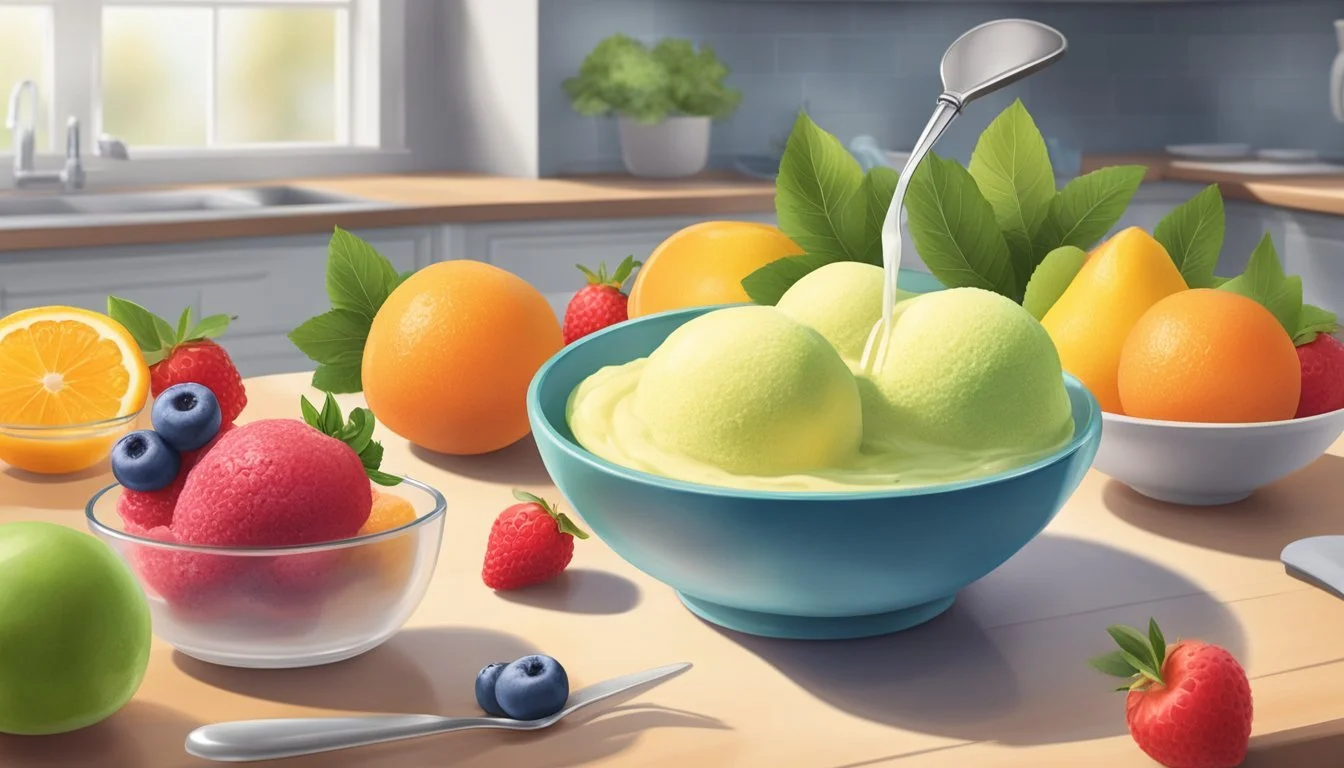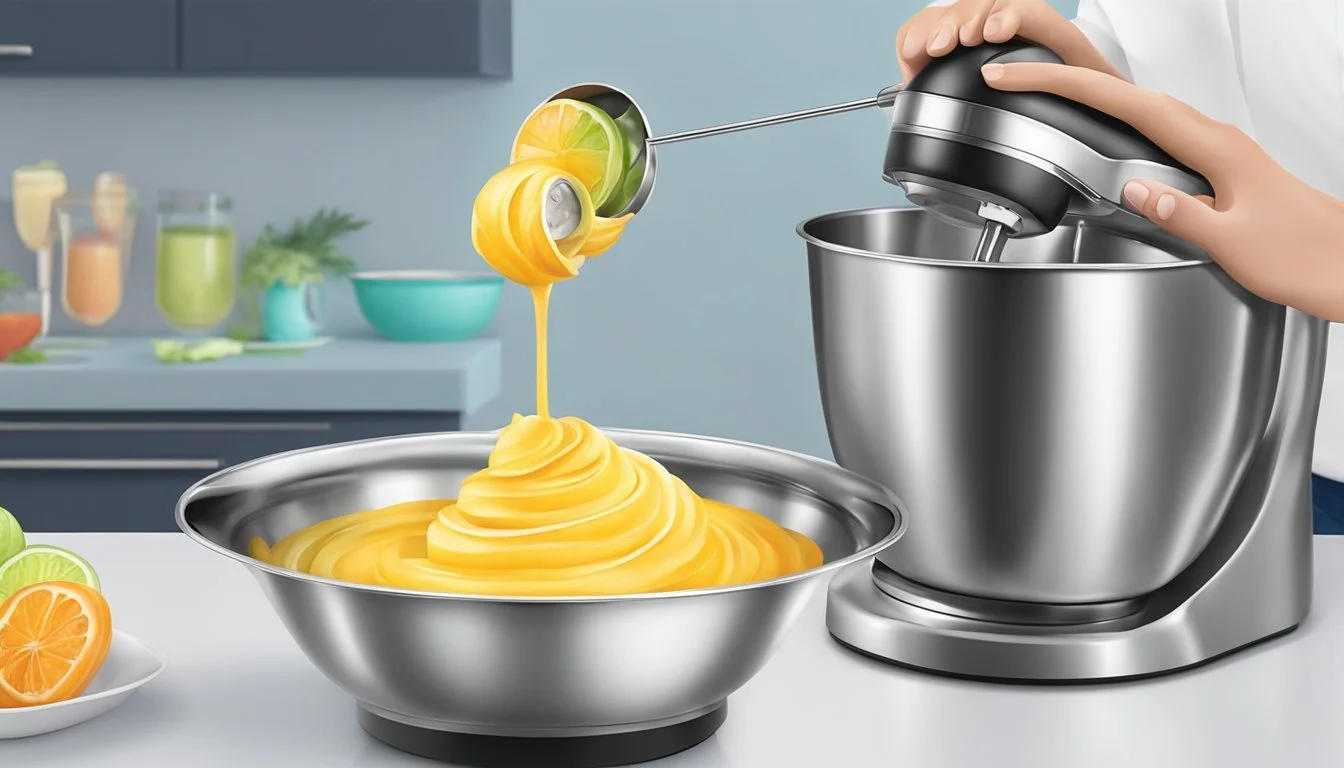How Long Does Sorbet Mix Last?
Shelf Life and Storage Tips
Sorbet, a popular frozen dessert known for its rich fruit flavor and smooth texture, has a variable shelf life depending on a few factors. Typically, sorbet mix—as in the unfrozen base—can last in the refrigerator for up to 48 hours. However, once the sorbet is churned and frozen, it can be kept in the freezer for up to a month before the quality starts to decline. To maintain the freshness and taste of homemade sorbet, it's critical to store it in an airtight container to prevent the formation of ice crystals and freezer burn.
The longevity of sorbet is contingent upon its ingredients and how it is stored. Sugar (how long does sugar last?) acts as a preservative and helps in keeping the sorbet from freezing solid, thus a higher sugar content can contribute to a longer shelf life, albeit with a potentially softer texture. When making sorbet at home, the mix should be promptly churned and frozen to preserve the integrity of the fruit flavors and prevent bacterial growth. The temperature of the freezer also plays a significant role; for optimal preservation, the sorbet should be stored at a consistent 0°F (-18°C) or colder.
If bought commercially, it's essential to adhere to the "best by" date provided by the manufacturer. If unopened, store-bought sorbet mix may last longer than homemade versions, thanks to additional stabilizers and preservatives. Consumers should also be diligent about returning the sorbet to the freezer immediately after serving to maintain its quality. If the sorbet has been thawed and refrozen multiple times, this cycle can significantly impact its flavor and texture, reducing its overall quality and lifespan.
Understanding Sorbet
In exploring the complexities of sorbet, one must consider its unique characteristics that set it apart from other frozen desserts. The following subsections delve into its definition and how it stands in comparison to similar treats.
Definition and Overview
Sorbet is a frozen dessert made from sweetened water with flavoring typically derived from fruit puree or juice. It is recognized for its dairy-free and often vegan composition, making it a popular choice amongst those with dairy restrictions or preferences. Unlike ice cream, sorbet does not contain dairy, relying instead on the high concentration of fruit for its structure and creamy texture when churned and frozen.
Comparison with Other Frozen Desserts
Frozen Dessert Dairy Content Texture Base Ingredients Ice Cream High Creamy, Rich Milk, Cream, Sugar Sorbet None Light, Icy Water, Fruit Puree, Sugar Frozen Yogurt High Creamy, Tangy Milk, Cultures, Sugar Gelato Medium Dense, Soft Milk, Less Cream, Sugar Sherbet Low Creamier than Sorbet Milk, Fruit Puree, Sugar
Sorbet differs from ice cream and gelato in that it is a dairy-free option, providing a light and refreshing flavor profile without the use of milk or cream. Frozen yogurt includes dairy but with a tangy flavor due to the bacterial cultures used in its production. Sherbet, much like sorbet, incorporates fruit but includes a small amount of dairy, giving it a slightly creamier texture when compared to the icier texture of sorbet. Despite the similarities in name, sorbet and sherbet are not the same—the latter includes dairy, distinguishing it from the dairy-free sorbet.
Key Ingredients
The quality and shelf life of a sorbet mix largely depend on the key ingredients used in its creation. These ingredients, each with a specific role, can affect the texture, flavor, and stability of the final product.
Common Ingredients in Sorbet
Sorbet typically includes a combination of fruit, sweeteners, and water. The choice of fruit is crucial as it not only imparts the primary flavor but also contributes natural sugars and acids to the mix. Citrus fruits (What wine goes well with fruits?), like lemons and limes, are often used for their juice, which adds a refreshing acidity. Pureed fruit or fruit juice serves as the base, with water added to adjust the intensity and consistency.
Fruit (fresh or puree)
Citrus (lemon or lime juice)
Water
Exploring Sweeteners and Acidity
Sweeteners are essential for sorbet to balance the tartness of the fruit and enhance the sorbet's overall flavor. Simple syrup, a mixture of water and granulated sugar, is commonly used due to its ability to dissolve easily and its neutral taste. Alternatives like honey can contribute additional flavor notes. The acidity often comes from citrus like lemon or lime juice, which is pivotal in heightening the perceived sweetness and refreshing quality.
Sweeteners (simple syrup, granulated sugar, honey)
Acid (citrus juice for balance)
Role of Alcohol and Eggs
While not present in all sorbets, alcohol and egg whites can be used to influence the texture. A small amount of alcohol can lower the freezing point, resulting in a softer sorbet that's easier to scoop. Egg whites—when whipped and incorporated—can lend a smoother mouthfeel by incorporating air into the sorbet. Both ingredients should be used judiciously to ensure the sorbet remains enjoyable and consistent in texture.
Alcohol (for lower freezing point)
Egg whites (for smoother texture)
Creating the Perfect Sorbet Base
The success of a sorbet depends heavily on the precise balance of its ingredients. Achieving the right mix ratio is crucial, as is the use of high-quality fruit purees.
The Science of Mix Ratios
For sorbet, the mix ratios between fruit, water, and sugar are essential. A standard ratio to aim for is:
2 parts fruit puree
1 part sugar syrup
Adjusting the sugar level affects the freezing point and texture. Too much sugar results in a mix that won't freeze properly, while too little causes the sorbet to freeze too hard. They should aim for a balance that achieves a sorbet consistency that is both scoopable and refreshing.
The Importance of Fruit Puree Quality
The base of any sorbet is the fruit puree. They should ensure that the purée is strained to remove excess fiber and pulp, which can lead to an undesirable texture in the finished product. However, it's essential to retain some of the pulp and pectin (how long does pectin last?), as they add natural thickness and body to the sorbet. Pectin also helps in stabilizing the mix.
Selecting the highest quality fruit is imperative. The fruit must be ripe and flavorful, as this will be the predominant taste of the sorbet. Varieties with higher natural sugars and solid flavors are more likely to produce a richer, more satisfying sorbet.
The Freezing Process
The freezing process is critical for achieving the desired texture in sorbet. Through proper methods and texture control, one can create a sorbet that is smooth and creamy rather than icy and grainy.
Methods of Freezing Sorbet
There are various tools one can use to freeze sorbet, each affecting the texture:
Ice Cream Maker: By churning the sorbet as it freezes, an ice cream maker ensures that air is incorporated into the mixture, contributing to a creamy texture and preventing large ice crystals from forming.
Blender or Food Processor: For those without an ice cream maker, using a blender or a food processor to blend the frozen sorbet mixture can break up ice crystals, although this method might not achieve the same creaminess as churning.
Controlling Texture and Consistency
The key to smooth, creamy sorbet lies in two main factors:
Sugar Syrup Concentration: The sugar content must be balanced to lower the freezing point and avoid either an overly hard or too soft consistency.
Churning Speed and Duration: Churning speed and duration influence how quickly the sorbet freezes and how creamy the final product becomes, with slower churners generally resulting in a creamier sorbet due to smaller ice crystals formation.
Flavoring and Enhancements
Crafting the perfect sorbet mix hinges on selecting high-quality fruits and complementary enhancements. Achieving a balance between sweetness and acidity is crucial for a sorbet that both tantalizes and satisfies the palate.
Fruit Varieties and Combinations
Fruit is fundament to sorbet. Choosing seasonal fruits ensures optimum flavor and sweetness. Berries, mangoes, and peaches are commonly used for their intense, natural flavors. For a bolder taste, stone fruits and melons offer a succulent base. Sorbet enthusiasts often create a symphony of flavors by pairing fruits, such as a strawberry sorbet infused with a hint of lime to elevate its zest, or blending lemon sorbet with citrus juice for a more rounded citrus profile.
Berries: Pair well with other berries or contrast with citrus.
Mango: Complements tropical fruits or offers a counterpoint to berry sharpness.
Peach Sorbet: Enriches with other stone fruits or contrasts with mint.
Citrus Juice: Enhances the sharpness in berry sorbets or adds complexity to melon sorbets.
Adding Herbs, Spices, and Other Flavors
The incorporation of herbs and spices transforms a simple sorbet into a gourmet experience. The subtle addition of mint can introduce a refreshing note to peach sorbet, while a pinch of bold spices in a saucepan might add warmth to mango sorbet. For a decadent twist, ribbons of chocolate sauce or flavored syrups can create surprising layers of taste.
Mint: Best when freshly chopped and infused into the sorbet base.
Herbs and Spices: Gentle simmering in a saucepan releases their full essence.
Chocolate: Melted and drizzled into the sorbet in the final stages for a marbled effect.
Approach flavoring with the aim of enhancing the sorbet's core attributes—fruity, refreshing, and smooth—by introducing complementary flavors that elevate the overall experience.
Sorbet Longevity and Storage
Sorbet's shelf life is highly dependent on storage conditions, with the ideal environment being a constant, freezing temperature. Factors such as temperature fluctuations and exposure to air can significantly impact sorbet's texture and flavor.
Optimal Storage Conditions
The key to maintaining sorbet's quality is in its storage. Sorbet should be stored at a temperature of 0°F (-18°C) to preserve its freshness and retard the growth of ice crystals, which can degrade its smooth texture. Using a refractometer to check the sugar content can be helpful in determining the optimal freezing point, as a higher sugar content lowers the freezing point, which can help in maintaining the desired viscosity and texture. To reduce the chance of textural changes, storage in an airtight container is recommended to prevent exposure to air and moisture.
Temperature for storage: 0°F (-18°C)
Container: Airtight
Tool: Refractometer (to check sugar content)
Extending Shelf Life
There are several methods to extend the shelf life of sorbet:
Minimize temperature changes: Store sorbet at a consistent temperature to avoid thawing and refreezing, which can lead to ice crystal formation.
Incorporate stabilizers: Stabilizers can be added to maintain texture and viscosity, making the sorbet less prone to melting or becoming too hard.
Manage air exposure: Limiting air exposure by ensuring the sorbet is covered tightly can help in maintaining its creamy consistency.
For extended storage beyond ordinary household needs, which typically ranges up to six months, one can refresh sorbet by thoroughly blending it before serving to re-integrate air and break down ice crystals. If sorbet contains alcohol, which acts as an antifreeze, this may modify the freezing characteristics and can prevent the mixture from freezing solid, thereby slightly extending its shelf life and maintaining a smoother texture.
Stabilizers: To improve consistency and prevent ice crystal formation
Refreshing technique: Blending before serving
Alcohol: Can prevent freezing solid and maintain smooth texture
Serving Suggestions
When serving sorbet, the focus is primarily on the complementing flavors and the presentation to enhance the dining experience.
Pairings and Presentation
Pairings:
A well-crafted sorbet is versatile and pairs beautifully with a range of complementary items. For a summer day dessert, one might consider serving lemon or peach sorbet with fresh berries or a fruit compote, taking advantage of the season's bounty. On hot summer days, a mint-infused sorbet can serve as a refreshing palate cleanser.
Fruit Salads: A citrus sorbet alongside a fruit salad offers a refreshing contrast.
Baked Desserts: Pair with light cakes or cookies for texture variety.
Cheese Plates: Try sorbets with cheeses during winter months for a surprising twist.
Presentation:
Presentation elevates the consumption of sorbet, transforming it from a simple frozen dessert to an elegant treat.
Cups vs. Spoons: Serve in chilled cups with small spoons to maintain the sorbet's texture as long as possible.
Garnishes: Accent with mint leaves or edible flowers for a touch of sophistication.
Proper Serving Techniques
Temperature:
Sorbets should be served cold but not too firm. They require a few minutes at room temperature before service to achieve the perfect consistency that's neither too hard nor too melty.
Service:
Serve quickly after removing from the freezer to prevent melting.
Use proper utensils, such as an ice cream scoop that's been warmed in hot water, for clean, even servings.
By adhering to these pairings, presentations, and serving techniques, one ensures that their sorbet recipes are showcased at their finest, regardless of whether it's a casual gathering or a formal event.
DIY Sorbet Making
Creating sorbet at home is a straightforward process that can yield delicious results. With the proper tools and techniques, one can craft a wide array of refreshing flavors.
Homemade Sorbet Tips
A successful homemade sorbet begins with high-quality fruit. The fruit used should be ripe and full of natural sweetness, as this reduces the need for additional sugar and enhances the final flavor. It's recommended to puree the fruit and then strain it to remove any seeds or pulp, ensuring a smooth texture. When making the sorbet base, a simple syrup—usually made from sugar and water—is often required to control the sweetness and consistency. Upon cooling the mixture, it should be frozen for a minimum of four hours to achieve the right sorbet consistency. Those who make it often might consider using a peeler for citrus fruits to add zest for a more intense flavor.
Selecting the Right Equipment
The equipment one chooses can greatly affect the texture and consistency of homemade sorbet. Here are the most commonly used tools:
Ice Cream Maker: An ice cream maker with a sorbet setting is ideal, as it is designed to churn the sorbet mixture, incorporating air and thereby creating a light, smooth texture.
Blender/Food Processor: For those who do not have an ice cream maker, a powerful blender or food processor can work as well. The mixture may need to be periodically stirred and refrozen to mimic the churning process.
Electric Whisk: A strong electric whisk can be used to aerate the mixture if a blender or food processor is not available. This requires frequent checking and whisking as the sorbet freezes.
While specialized equipment like an ice cream maker can yield the best results, a blender or food processor can also produce a quality homemade sorbet with some additional effort and attention to the freezing process.
Health Considerations
When assessing the health aspects of sorbet mix, it's prudent to consider both the nutritional value and any potential allergens or dietary restrictions that consumers may need to be aware of. This section will provide specific insights into these areas, bearing in mind the diversity of ingredients that can be found in various sorbet mixes.
Nutritional Value
Fruit Puree: Sorbets often contain high amounts of fruit puree, which can be a good source of dietary fiber and essential vitamins.
Sugar Content: They usually have a sugar concentration of 20% to 30%, which impacts the nutritional value and calorie count.
Allergens and Dietary Restrictions
Dairy-Free and Vegan: Sorbet mixes typically do not contain dairy, making them a suitable choice for individuals with lactose intolerance or those following a vegan diet.
Egg-Free: They are also generally egg-free, further widening their appeal to those with egg allergies or dietary restrictions.
Alcohol: Some sorbet recipes may incorporate alcohol for flavor, which should be considered by those avoiding alcohol for health, personal, or religious reasons.
Advanced Sorbet Techniques
Achieving the perfect sorbet requires precision and understanding advanced techniques that can elevate its texture and flavor. Mastering the Master Ratio and utilizing additives can make a significant difference in the quality of the final product.
Master Ratio Calculations
The master ratio of fruit to sugar is pivotal in sorbet making, as it dictates sweetness and consistency. A common starting point is a 5:1 ratio of fruit to sugar. However, a refractometer can be used to measure sugar content more accurately. This instrument helps achieve the desired 20-30% sugar ratio, which ensures proper freezing point depression and results in a smoother sorbet.
A higher fruit ratio contributes to the fiber content, which can naturally enhance the viscosity and creaminess of the sorbet without additional additives. Adjustments are made based on the fruit's natural sweetness and water content to find the ideal balance.
Using Additives for Texture
Additives such as pectin, gelatin, and commercial stabilizers play a role in modifying the texture of sorbet. These agents increase the mixture's viscosity, providing a creamier texture and helping prevent the formation of ice crystals.
Pectin: Typically used with fruits low in natural pectin, it helps with gelation and improves mouthfeel.
Gelatin: It can provide a smoother texture in sorbet, but it is not suitable for vegan diets.
Additive Purpose in Sorbet Benefit Pectin Gelation, enhances mouthfeel Reduces iciness Gelatin Provides a smoother texture Improves creaminess Stabilizers Improves stability, texture Extends shelf life, reduces melting
For each additive, they must be used sparingly to avoid overly thick or gummy results. The use of these substances should complement the natural qualities of the fruit, not overshadow them.











